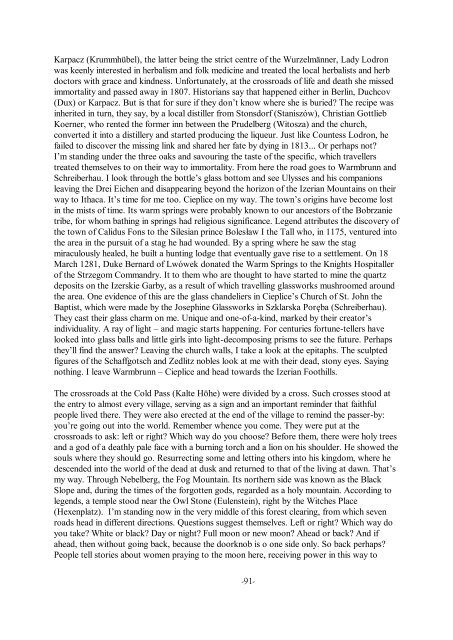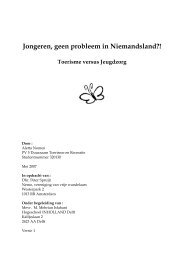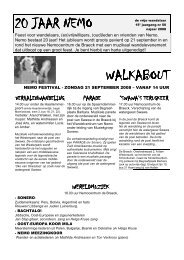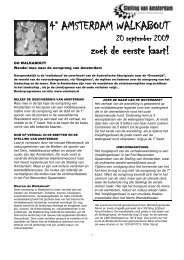Glashütten des Spätmittelalters im Isergebirge - Nemo
Glashütten des Spätmittelalters im Isergebirge - Nemo
Glashütten des Spätmittelalters im Isergebirge - Nemo
Erfolgreiche ePaper selbst erstellen
Machen Sie aus Ihren PDF Publikationen ein blätterbares Flipbook mit unserer einzigartigen Google optimierten e-Paper Software.
Karpacz (Krummhübel), the latter being the strict centre of the Wurzelmänner, Lady Lodron<br />
was keenly interested in herbalism and folk medicine and treated the local herbalists and herb<br />
doctors with grace and kindness. Unfortunately, at the crossroads of life and death she missed<br />
<strong>im</strong>mortality and passed away in 1807. Historians say that happened either in Berlin, Duchcov<br />
(Dux) or Karpacz. But is that for sure if they don’t know where she is buried? The recipe was<br />
inherited in turn, they say, by a local distiller from Stonsdorf (Staniszów), Christian Gottlieb<br />
Koerner, who rented the former inn between the Prudelberg (Witosza) and the church,<br />
converted it into a distillery and started producing the liqueur. Just like Countess Lodron, he<br />
failed to discover the missing link and shared her fate by dying in 1813... Or perhaps not?<br />
I’m standing under the three oaks and savouring the taste of the specific, which travellers<br />
treated themselves to on their way to <strong>im</strong>mortality. From here the road goes to Warmbrunn and<br />
Schreiberhau. I look through the bottle’s glass bottom and see Ulysses and his companions<br />
leaving the Drei Eichen and disappearing beyond the horizon of the Izerian Mountains on their<br />
way to Ithaca. It’s t<strong>im</strong>e for me too. Cieplice on my way. The town’s origins have become lost<br />
in the mists of t<strong>im</strong>e. Its warm springs were probably known to our ancestors of the Bobrzanie<br />
tribe, for whom bathing in springs had religious significance. Legend attributes the discovery of<br />
the town of Calidus Fons to the Silesian prince Bolesław I the Tall who, in 1175, ventured into<br />
the area in the pursuit of a stag he had wounded. By a spring where he saw the stag<br />
miraculously healed, he built a hunting lodge that eventually gave rise to a settlement. On 18<br />
March 1281, Duke Bernard of Lwówek donated the Warm Springs to the Knights Hospitaller<br />
of the Strzegom Commandry. It to them who are thought to have started to mine the quartz<br />
deposits on the Izerskie Garby, as a result of which travelling glassworks mushroomed around<br />
the area. One evidence of this are the glass chandeliers in Cieplice’s Church of St. John the<br />
Baptist, which were made by the Josephine Glassworks in Szklarska Poręba (Schreiberhau).<br />
They cast their glass charm on me. Unique and one-of-a-kind, marked by their creator’s<br />
individuality. A ray of light – and magic starts happening. For centuries fortune-tellers have<br />
looked into glass balls and little girls into light-decomposing prisms to see the future. Perhaps<br />
they’ll find the answer? Leaving the church walls, I take a look at the epitaphs. The sculpted<br />
figures of the Schaffgotsch and Zedlitz nobles look at me with their dead, stony eyes. Saying<br />
nothing. I leave Warmbrunn – Cieplice and head towards the Izerian Foothills.<br />
The crossroads at the Cold Pass (Kalte Höhe) were divided by a cross. Such crosses stood at<br />
the entry to almost every village, serving as a sign and an <strong>im</strong>portant reminder that faithful<br />
people lived there. They were also erected at the end of the village to remind the passer-by:<br />
you’re going out into the world. Remember whence you come. They were put at the<br />
crossroads to ask: left or right? Which way do you choose? Before them, there were holy trees<br />
and a god of a deathly pale face with a burning torch and a lion on his shoulder. He showed the<br />
souls where they should go. Resurrecting some and letting others into his kingdom, where he<br />
<strong>des</strong>cended into the world of the dead at dusk and returned to that of the living at dawn. That’s<br />
my way. Through Nebelberg, the Fog Mountain. Its northern side was known as the Black<br />
Slope and, during the t<strong>im</strong>es of the forgotten gods, regarded as a holy mountain. According to<br />
legends, a temple stood near the Owl Stone (Eulenstein), right by the Witches Place<br />
(Hexenplatz). I’m standing now in the very middle of this forest clearing, from which seven<br />
roads head in different directions. Questions suggest themselves. Left or right? Which way do<br />
you take? White or black? Day or night? Full moon or new moon? Ahead or back? And if<br />
ahead, then without going back, because the doorknob is o one side only. So back perhaps?<br />
People tell stories about women praying to the moon here, receiving power in this way to<br />
-91-
















